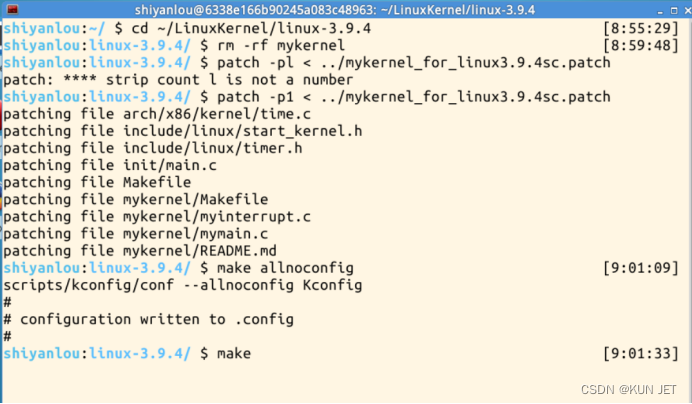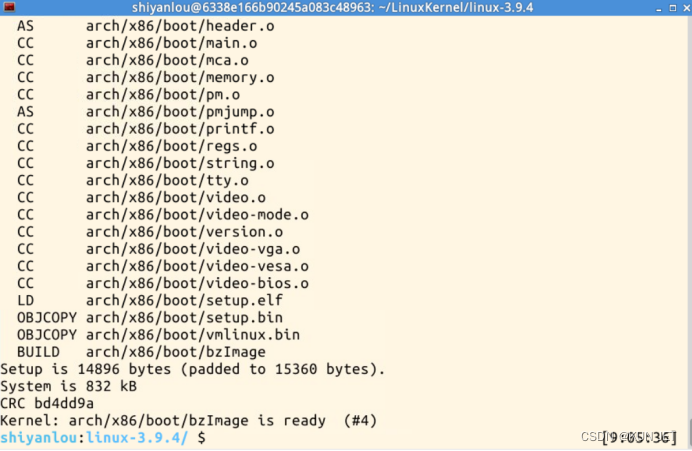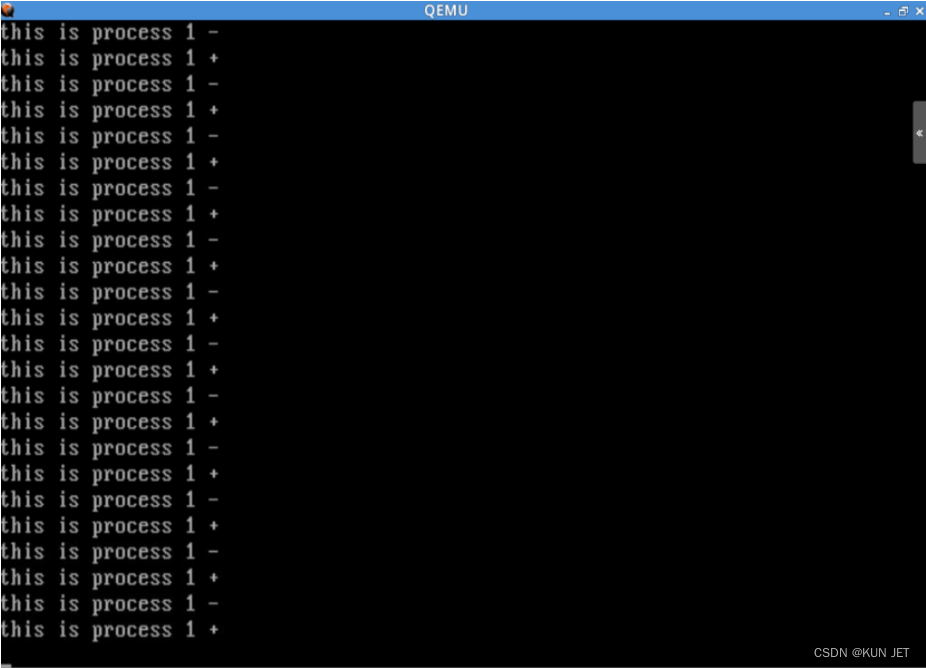2022-2023-1 20222814《Linux内核原理与分析》第三周作业
实验二 mykernel 实验
1、打开shell终端

2、使用make命令编译内核

3、编译完成后,使用qemu -kernel arch/x86/boot/bzImage命令,可以看到程序进入死循环

完成一个简单的时间片轮转多道程序内核代码
1、修改mymain.c文件,实现内核代码的入口,负责初始化内核的各个组成部分
代码如下:
#include <linux/types.h>
#include <linux/string.h>
#include <linux/ctype.h>
#include <linux/tty.h>
#include <linux/vmalloc.h>
#include “mypcb.h”
tPCB task[MAX_TASK_NUM];
tPCB * my_current_task = NULL;
volatile int my_need_sched = 0;
void my_process(void);
void __init my_start_kernel(void)
{
int pid = 0;
int i;
/* Initialize process 0*/
task[pid].pid = pid;
task[pid].state = 0;/* -1 unrunnable, 0 runnable, >0 stopped */
task[pid].task_entry = task[pid].thread.ip = (unsigned long)my_process;
task[pid].thread.sp = (unsigned long)&task[pid].stack[KERNEL_STACK_SIZE-1];
task[pid].next = &task[pid];
/fork more process /
for(i=1;i<MAX_TASK_NUM;i++)
{
memcpy(&task[i],&task[0],sizeof(tPCB));
task[i].pid = i;
task[i].thread.sp = (unsigned long)(&task[i].stack[KERNEL_STACK_SIZE-1]);
task[i].next = task[i-1].next;
task[i-1].next = &task[i];
}
/ start process 0 by task[0] /
pid = 0;
my_current_task = &task[pid];
asm volatile(
“movl %1,%%esp\n\t” / set task[pid].thread.sp to esp /
“pushl %1\n\t” / push rbp /
“pushl %0\n\t” / push task[pid].thread.ip /
“ret\n\t” / pop task[pid].thread.ip to rip /
:
: “c” (task[pid].thread.ip),“d” (task[pid].thread.sp) / input c or d mean %ecx/%edx/
);
}
int i = 0;
void my_process(void)
{
while(1)
{
i++;
if(i%10000000 == 0)
{
printk(KERN_NOTICE “this is process %d -\n”,my_current_task->pid);
if(my_need_sched == 1)
{
my_need_sched = 0;
my_schedule();
}
printk(KERN_NOTICE “this is process %d +\n”,my_current_task->pid);
}
}
}
2、修改myinterrupt.c,实现进程切换
代码如下:
#include <linux/types.h>
#include <linux/string.h>
#include <linux/ctype.h>
#include <linux/tty.h>
#include <linux/vmalloc.h>
#include “mypcb.h”
extern tPCB task[MAX_TASK_NUM];
extern tPCB * my_current_task;
extern volatile int my_need_sched;
volatile int time_count = 0;
/*
- Called by timer interrupt.
- it runs in the name of current running process,
- so it use kernel stack of current running process
*/
void my_timer_handler(void)
{
if(time_count%1000 == 0 && my_need_sched != 1)
{
printk(KERN_NOTICE “>>>my_timer_handler here<<<\n”);
my_need_sched = 1;
}
time_count ++ ;
return;
}
void my_schedule(void)
{
tPCB * next;
tPCB * prev;
if(my_current_task == NULL
|| my_current_task->next == NULL)
{
return;
}
printk(KERN_NOTICE “>>>my_schedule<<<\n”);
/* schedule /
next = my_current_task->next;
prev = my_current_task;
if(next->state == 0)/ -1 unrunnable, 0 runnable, >0 stopped /
{
my_current_task = next;
printk(KERN_NOTICE “>>>switch %d to %d<<<\n”,prev->pid,next->pid);
/ switch to next process /
asm volatile(
“pushq %%rbp\n\t” / save rbp of prev /
“movq %%rsp,%0\n\t” / save rsp of prev /
“movq %2,%%rsp\n\t” / restore rsp of next /
“movq $lf,%1\n\t” / save rip of prev /
“pushq %3\n\t”
“ret\n\t” / restore rip of next /
“1:\t” / next process start here */
“popq %%rbp\n\t”
: “=m” (prev->thread.sp),“=m” (prev->thread.ip)
: “m” (next->thread.sp),“m” (next->thread.ip)
);
}
return;
}
3、创建mypcb.h定义PCB
define MAX_TASK_NUM 4
#define KERNEL_STACK_SIZE 10242
/ CPU-specific state of this task */
struct Thread {
unsigned long ip;
unsigned long sp;
};
typedef struct PCB{
int pid;
volatile long state; /* -1 unrunnable, 0 runnable, >0 stopped /
unsigned long stack[KERNEL_STACK_SIZE];
/ CPU-specific state of this task */
struct Thread thread;
unsigned long task_entry;
struct PCB *next;
}tPCB;
void my_schedule(void);
4、返回上一目录后,重新make,结果如下






















 476
476











 被折叠的 条评论
为什么被折叠?
被折叠的 条评论
为什么被折叠?








